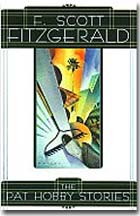Books |
The Pat Hobby Stories
F. Scott Fitzgerald
By
Published: Jan 01, 2008
Category:
Fiction
That Scott Fitzgerald — he was really funny.
And you are thinking: Where? What were the laughs I missed in The Great Gatsby — the body floating in the pool? Was there something comic in the twisted romances and crackups in This Side of Paradise or Tender Is the Night? And were story conferences in The Last Tycoon wet-your-pants funny?
You haven’t read The Pat Hobby Stories.
Odds are, you’ve never heard of them.
There’s a reason. These 17 stories were the last Fitzgerald wrote, when he was sick and just scraping by in Hollywood. He wrote them for money — hell, he wrote almost every word of his career for money — but the writer who used to command thousands from The Saturday Evening Post was reduced to Western Union payments of $100 and less from Esquire. And then, at 44, he died, his fabled career as doomed as the Charleston.
Even for a writer, that’s a sad story.
And then there’s Pat Hobby.
Pat was once a screenwriter of note, a potentate with a driver and a swimming pool. Alas, most of his 30 screenwriting credits date back to the Silent Era. In the late 1930s and 1940, he’s a 49-year-old bum, a hack with no ideas, a modest gambling habit, a big thirst for booze, and no money coming in to finance any of it. He can’t get a date. He can hardly get a job.
Even for fiction about a writer, that’s a sad character.
And, armchair critics might quickly add, sadder still, for who can’t see Fitzgerald just under Pat Hobby’s skin?
The problem with easy analysis and quick dismissal is that the Pat Hobby stories are very funny — in the wry, black humor way that the last half century has taught us to regard as comic.
Pat Hobby, broke as usual and marking his last few days of studio employment, cooks up a Christmas plot that calls for nothing less than… blackmail.
Pat Hobby needs an idea for a scene. He steals one from an attractive young woman who’s new to the Writers’ Building. Only she turns out to be….
“Boil some water — lots of it!” A line of dialogue. For Pat, a career achievement. But then life imitates art…
Pat is “teamed with genius” — instructed by the studio to collaborate on a script about ballet with a young writer who might just be “that way”. The collaborator can’t stand working with Pat. But he surely can write a script. Pat’s contribution would be evil — if only he weren’t so inept.
Then there’s Pat in a beard, made up to look like dish-of-the-day Orson Welles. And Pat’s odd afternoon as a guide to the stars’ homes. And Pat’s encounter with Indian royalty and its possible financial boon. And Pat being not exactly being invisible on a movie set. And the preview of a movie that Pat has cadged a credit on — could there be something awry with the tickets?
Pat Hobby is Harold Lloyd. Or Mr. Bean. Or a Samuel Beckett character. He has no choice — against impossible odds, he must try. You know he can’t win, and he doesn’t, but the effort seems familiar and laudable, even if the situations are ridiculous. And the writing is clean, the dialogue snappy, the observations about human character dead-on.
“Pat Hobby sent me through Vassar,” Fitzgerald’s daughter remarked, when asked about these stories.
Pat Hobby can send you back to a simpler time, when film studios were factories and writers cranked scripts out like sausage and $10 was real money. But even more, to a time when pratfalls were funny, and you could see a dramatic reversal coming a page away, and a hack could be a comic character worth cherishing.
To buy “The Pat Hobby Stories” from Amazon.com, click here.
To buy “The Great Gatsby” from Amazon.com, click here.
To buy “This Side of Paradise” from Amazon.com, click here.
To buy “Tender Is the Night” from Amazon.com, click here.
To buy “The Last Tycoon” from Amazon.com, click here.
To read more about “Everybody Was So Young” on HeadButler.com, click here.


